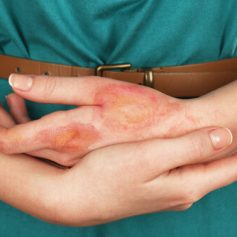
A burn injury is not only painful but it can also result in catastrophic injuries that can cause death in severe cases. One in four victims in the United States today dies as a result of their severe burn injuries. Survivors may suffer disfigurement, nerve damage, shock, limb amputation and/or blood vessel, bone or muscle damage. Treatment can be costly, and the pain and suffering associated with a burn injury can be debilitating.
When you put your burn injury claim in the hands of the Sloan Firm, you will be represented by a team of skilled attorneys ready to fight vigorously for you. Our burn injury lawyers, investigators, paralegals and support staff can carefully evaluate your case.
We take the time to get to know you and every detail of your case. Our compassionate and knowledgeable staff doesn’t just look at the injuries. We see the person behind the injury.
Our personal injury lawyers help burn injury victims in Houston, Sante Fe, and Longview.
Types and Causes of Burns
Burn injuries are rated in degrees from first to fourth. A first-degree burn is the mildest and damages only the first layer of skin. A fourth-degree burn can cause damage to deep tissue, bone, muscle and blood vessels. Fourth-degree burns can lead to irreversible damage and, in many cases, death.
Types of burn injuries include:
- Heat burns. Burns from heat are the most common and along with chemical burns, can be the most severe, and may be caused by fire, steam, hot liquids, or other hot objects. Heat burns are common in motor vehicle accidents and can also happen in workplace accidents or as a result of a faulty product, for example.
- Chemical burns. Chemical burns are caused by contact with chemicals that irritate, deform or dissolve skin and tissue. Chemical burns can also occur in the workplace or with a faulty product.
- Cold temperature burns. These are caused by exposure to cold, windy conditions.
- Electrical burns. Electrical burns are caused by lightning or other sources of electricity. These are tragically common in the workplace.
- Radiation burns. These are caused by exposure to the sun, UV lamps (like those used for indoor tanning), or radiation therapies used to treat cancer.
Burn Treatments and Complications
Minor burns may be treated at home by cleaning the wounded area, applying an antibiotic ointment (as long as the skin is not broken) and wrapping it loosely to protect the wound and give it time to heal.
If the burn is second degree or higher, it should be treated by medical personnel. For second degree burns, health care providers may use anti-inflammatory drugs to reduce swelling and use certain wound dressings, like a hydrocolloid dressing, to allow the wound to heal. If the wound is a blistering wound, they may use a hydrogel dressing.
If you have a third-degree burn, wound treatment may include removing dead tissue (debriding), using skin grafts, and possibly physical therapy.
Serious burns can develop other complications if they are deep or widespread. These complications include:
- Infection. Burns can leave skin vulnerable to bacterial infection and increase the risk of sepsis. Sepsis is a life-threatening infection that travels through the bloodstream and affects the whole body. It progresses rapidly and can cause shock and organ failure.
- Scarring. As the burn wounds are healing, an overgrowth of scar tissue could produce ridged areas on the skin. These scars may cause permanent disfigurement.
- Low blood volume. Burns can cause damage to blood vessels, which can result in low blood volume, which means the body does not get the amount of blood it needs to function well.
- Dangerously low body temperature. Skin plays a large role in regulating body temperature. Damage to the skin through burns can lead to body heat loss. Large losses in body heat can lead to hypothermia, where the body is too cold because it loses heat faster than it can produce it.
- Respiratory problems. If the burn injuries happened in a fire, the injured person may also have breathed in smoke or air hot enough to burn airways and cause difficulty breathing. Inhaling smoke can also damage lungs and cause respiratory failure.
- Joint problems. If a burn injury is deep, scar tissue can form over the injury and limit joint movement. The scar tissue can cause the skin, muscles or tendons to tighten, possibly putting joints out of position.
Types of Compensation Available for Burn Injuries
If you have suffered a serious burn injury, you may have medical bills piling up with the prospect of months or years of treatments. You may not be able to hold the job you previously had or you may need years of therapy to manage your change in circumstances. Compensation is intended to provide some monetary relief for your suffering.
The types of compensation that may be available to you include:
- Medical expenses
- Pain and suffering
- Therapy
- Physical impairment
- Lost income and earning capacity
- Loss of enjoyment of life
- Loss of consortium
- Property damage
- Wrongful death
What to Do for a Severe Burn Injury that Wasn’t your Fault
If you have suffered a serious burn injury due to another’s negligence, you need someone to fight for your legal rights. Once you have begun to receive medical care for your injury, contact us so we can lighten your load by gathering the information necessary to pursue your claim.
At the Sloan Firm, what matters to you, matters to us. Contact a personal injury attorney from the Sloan Firm today. We have lawyers ready to help you in Longview, Houston, and Santa Fe. We can provide advice and guidance to help you through this painful experience.

 A burn injury is not only painful but it can also result in catastrophic injuries that can cause death in severe cases. One in four victims in the United States today dies as a result of their severe burn injuries. Survivors may suffer disfigurement, nerve damage, shock,
A burn injury is not only painful but it can also result in catastrophic injuries that can cause death in severe cases. One in four victims in the United States today dies as a result of their severe burn injuries. Survivors may suffer disfigurement, nerve damage, shock,